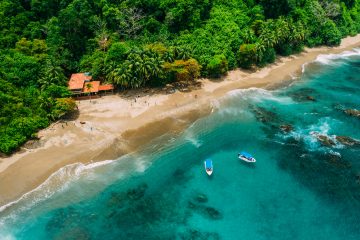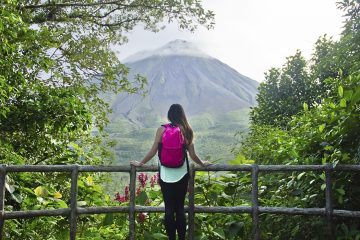No one’s surprised to find that Canada is chock-full of natural beauty and stunning sights. From National Parks to coastline and beaches, there’s an incredible amount of wilderness and natural places. With so much to choose from, it might be hard to know where to begin—here’s 12 of our favorite destinations and top spots to choose from.
Lake O’Hara in Yoho National Park
Yoho National Park is in the Rocky Mountains of Eastern British Columbia, and although it’s a bit less popular than places like Banff or Jasper National Parks, it’s just as beautiful and well-worth a visit! One of our absolute favorite spots in Canada is Lake O’Hara, a crystal-clear turquoise lake with stunning alpine views. And because it’s a bit of a trek (7 miles each way) to get up to it, it’s much less frequented by tourists than places like Lake Louise or Lake Moraine (also both worth visiting).
Many sections of the Lake O’Hara region and Yoho National Park require advance permits for camping or even for day-use of the wilderness areas. Be sure to check in advance what permits are required, if any, for the areas you plan to visit.
Fly: Calgary or Vancouver are the closest major airports. You’ll probably want to rent a car if you’re planning on doing lots of National Park sightseeing, although some airport shuttles to the parks are available.
Best time to visit: mid-May through early October for the best weather and most campgrounds and outdoor activities. This is also the busiest season, so plan accordingly.
Maligne Canyon in Jasper National Park
Jasper National Park is the largest national park in Alberta’s Rocky Mountains, which means there’s plenty of wilderness and gorgeous scenery to explore. From waterfalls to glaciers, turquoise lakes to alpine mountains, there’s plenty to see. One of the most stunning places in the park is Maligne Canyon. In the summer, covered bridges cross over stunning waterfalls through canyon walls, while in the winter, you can explore the canyon floor covered in snow and ice.
If you’re looking for more mountains, the Bald Hills, Sulphur Skyline Trail or the Valley of Five Lakes will give you exactly what you’re looking for.
Fly: Edmonton or Calgary, although both are several hours drive away. You’ll want to rent a car.
Best time to visit: Visit during April-May or September-October. You’ll have slightly chilly weather (but still good enough to be outside and hiking) but you’ll miss most of the summer crowds.
Garibaldi Provincial Park
Located just under 2 hours from Vancouver, British Columbia, Garibaldi Provincial Park is a stunning place to experience some of the best Canadian scenery. If you want alpine lakes, go for Garibaldi Lake or Wedgemount Lake. For skiing, try Blackcomb Peak. And Brandywine Falls is a stunning waterfall any time of year!
Fly: Vancouver International Airport (about 1.5 hours away)
Best time to visit: The best weather is between May and September, however, there’s plenty to enjoy in the winter as well, especially if you have snowshoes!
Lake Athabasca Sand Dunes
These sand dunes are super unique territory for Canada—amid alpine mountain ranges and lakes, these miles of sand dunes are among the most northerly sand dune formations on Earth. The otherworldly dunes are full of unique plants and provide stunning views that look like you’re in Mars—not far north in Saskatchewan. They’re super remote, though, so you’ll need to plan in advance. You can only reach them by float plane or boat.
Fly: Edmonton, although even Edmonton is quite a ways from this remote area. You can fly in from Fort McMurray, or you can drive to Uranium City or Fond du Lac and then take a boat in from there.
Best time to visit: Definitely during the summer. This area is quite far north in Canada, so you’ll want to head up during the warmer months.
Cape Breton Highlands National Park
Cape Breton Island sits on the Eastern edge of the coast of Canada, but is well-worth a visit for the sweeping scenery and both mountain and ocean views. Plan a road trip along the Cabot Trail, an approximately 5-hour drive around the most scenic parts of Cape Breton island, featuring coastal cliffs and picturesque seaside towns. The Highlands National Park is home to some seriously scenic trails, including Skyline Trail and Acadian Trail.
Fly: Fly into Halifax and then drive to Cape Breton Island.
Best time to visit: Summer is the warmest and driest season, but fall is undoubtedly the most gorgeous—you’ll find fall colors everywhere!
Horseshoe Canyon
Horseshoe Canyon looks like something out of Arizona, not Alberta—and yet, it’s just an hour from Calgary. This scenic canyon and prairielands will definitely make you feel like you’re on a different planet. There’s plenty of picture-perfect lookouts and several trails so you can explore the canyon floor or the view from the top. Either way, the views here are a lot better than the views from your local Tim Horton’s, so get to Horseshoe Canyon ASAP.
Fly: Calgary’s your best bet.
Best time to visit: March-May and September-October are good times. Summer is lovely, but more touristed.
Abraham Lake
Abraham Lake is stunning each winter as soon as it freezes over. The beautiful bubbles are actually methane that forms the white bubbles when it comes into contact with freezing water, and then freezes into layers. This natural phenomenon is super magical, and it’s the perfect way to explore outdoors in the long, cold winters—not to mention get some pics for your Instagram.
Fly: Calgary or Edmonton (it’s about 3 hours from each).
Best time to visit: January and February are typically the best months for bubbles.
Banff National Park
If you’ve had an Instagram for any length of time, you’ve likely seen pictures of Banff National Park pop up on your feed. It’s picture-perfect lakes and striking mountains make for the perfect backdrop. While it’s more crowded than other stops on this list, it’s definitely worth a visit at least once! Just make sure you visit the most popular stops early in the day, before the crowds arrive.
Fly: Calgary—Banff is only 80 miles west of Calgary. There’s some transit options available, but a car is definitely your best bet for getting around.
Best time to visit: Summer months are CROWDED. Visit during March-May or September-October.
Stanley Glacier
The stunning views and panoramas in this hike will make you feel like you’re on another planet (or at least another continent…) but it’s relatively easy to access. Located just two hours from Calgary and right near Banff National Park, it’s a great stop on any Banff road trip. From snowy pines in the winter to wildflower-covered meadows in the late spring, it’s a spectacular hike—and of course, you can see the glacier at the end of it!
Fly: Calgary
Best time to visit: While you could visit any time of year, summer, of course, brings the best weather. Most importantly, try to get as early of a start as possible, as the trail gets crowded throughout the day.
Baffin Island, Nunavut
Baffin Island is Canada’s largest island, located in the far north is a vast Arctic wilderness. If you’re looking for somewhere to get seriously off the grid, this is it! And while it may not be an up-and-coming vacation destination, it is definitely otherworldly in just how remote it is and with views that are unlike anywhere else. It’s obviously chilly even in the summer months, but hiking trails abound, plus there’s plenty of glaciers and fjords to explore too!
Fly: You’ll need to fly from Ottawa or Montreal. It depends on where you’re going, but Iqaluit or Rankin Inlet are two of the main airports in the region.
Best time to visit: Summer, of course, has the warmest weather. And since there’s not many tourists, you won’t have to worry about that!
Montmorency Falls
While Niagara Falls is no doubt the most famous waterfall in Canada, Montmorency Falls is also stunning—and it’s almost 100 feet higher than Niagara! And it’s located right within Quebec City, making it a super easy escape. Experience the falls from trails, the overlooking suspension bridge or a tram.
Fly: Quebec City International Airport or Montreal are the best nearby hubs.
Best time to visit: It’s a snowy wonderland during the winter (which is super beautiful!) But if you’re not used to the cold winters in Canada, visit during the warmer summer months.
Gros Morne National Park
This UNESCO World Heritage site is located at the edge of Newfoundland, Canada; home to fjords, waterfalls, beaches and tons of hiking. Our favorite thing in the park, though? The striking Tablelands, where you can walk over the exposed earth’s red mantle. The best part of Gros Morne is simply how natural and untouched it feels—despite being easy to access.
Fly: Deer Lake Regional Airport is the nearest airport, but St. John’s International Airport (on the other side of the island) is a bigger international option.
Best time to visit: September brings good weather (albeit a bit rainy at times) and much fewer tourists. Summer is beautiful, but high season means more crowds and higher prices.
Ready to book a flight into the Canadian wilderness? Check out our flights to Canada now!


